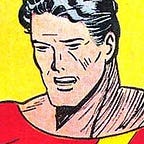Paul Tremblay’s “Them: A Pitch” utilizes the unique narrative format of a comics pitch
In the short story “Them: A Pitch” from writer Paul Tremblay, a haggard man travels alone through a bleak desert landscape that features tall monolithic structures built by giant ants. The story’s apocalyptic setting and prominent use of monster insects are openly influenced by such horror films as Them! (1954) and Phase IV (1974), but Tremblay employs a unique narrative format to render his tale — a comics pitch. This format provides an engaging experience for readers, and it highlights the craft of pitching comics.
The narrator of “Them: A Pitch” addresses the editor of a forthcoming comics anthology, pitching a story for the anthology. The narrator acknowledges inexperience with writing comics, but also expresses a love for the medium.
The narrator suggests a visual style for the proposed ten-page strip:
There will be no dialogue or narrative commentary in this story. It will be told exclusively via the images/art. The art will be black-and-white, with an aesthetic of Charles Burns’s Black Hole (see, I told you I read comics) mashed up with 1950s atomic monster movies. A stark or minimalist style while also looking like it might’ve come from a Twilight Zone episode.
In addition to admitting the influence of Burns’s black-and-white horror comic Black Hole and the television series The Twilight Zone, the narrator mentions the films Them!, Phase IV, and Close Encounters of the Third Kind, as well as the Family Circus comic strip, as possible visual inspirations for the comic.
Via the pitch, the narrator outlines the comic’s story beats: the lone traveler comes upon a community of human survivors; despite having some initial suspicion, this community eventually welcomes the traveler; the survivors are later attacked by a troop of giant ants; the community fights back, and then an interesting plot twist occurs.
Tremblay employs the pitch format to present a significant amount of information in a very short narrative. Using about 800 words, with no dialogue and minimal character descriptions, the pitch creates an engaging world that contains interesting characters and scary monsters, all within a comic strip created in the reader’s mind.
While the story is identified as a comics “pitch,” Tremblay’s use of that term is professionally inaccurate; with its detailed plot points, Tremblay’s chosen narrative format is arguably a comics “outline.” In Words for Pictures: The Art and Business of Writing Comics and Graphic Novels, comics creator Brian Michael Bendis (whose work includes Ultimate Spider-Man, Powers, and Torso, among other titles) explains the difference between a comics pitch and an outline:
A pitch document is a quick one or two paragraph document that describes the story or series the writer is trying to sell. A story outline is a somewhat more involved document that goes into more detail about story beats and character arcs.
This mislabeling of the story as a “pitch” can be attributed to the narrator’s stated inexperience with writing comics, as well as Tremblay’s own unfamiliarity with the format. In recounting the story’s creative origins, Tremblay — known for his award-winning prose horror novels, such as A Head Full of Ghosts and The Cabin at the End of the World — acknowledges this inexperience:
I held on to the idea for this short giant ant story (and yeah, Them! and Phase IV are two of my favorite films; to wit, I wrote an essay about Phase IV for the book Lost Transmissions), thinking that, maybe it could be a short comic, one without any dialogue. But I didn’t and don’t know anything about writing comic scripts.
“Them: A Pitch” was eventually published as a prose story in the Southwest Review’s October 2020 horror issue. While Tremblay’s story was apparently never adapted into a comic strip, its narrative format highlights the craft involved in communicating visual information to comics editors and artists via prose, and it serves as a neat love letter to both the comics medium and giant ants.
NOTES AND FURTHER READING:
The Beast You Are: Stories (Paul Tremblay; William Morrow, 2023) [This short story collection includes both “Them: A Pitch” and Tremblay’s comments on the story’s publication history.]
Lost Transmissions: The Secret History of Science Fiction and Fantasy (Desirina Boskovich, et al.; Abrams Image, 2019) [This book features Tremblay’s essay “Behold, the Science-Fiction Cosmic Horror of Phase IV!”]
Words for Pictures: The Art and Business of Writing Comics and Graphic Novels (Brian Michael Bendis; Watson-Guptill, 2014)
Attention, all Secret Dictionary Club members — use Code Eight to decipher the following message: WCZ IOMVBA PIDM TWKIBML BPM NCOQBQDM DIUXQZM UWJABMZ QV KPQKIOW.
BONUS COMIC STRIP:
The text and images above are the property of their respective owner(s), and are presented here for not-for-profit, educational, and/or review purposes only, under the fair use doctrine of the copyright laws of the United States of America.
